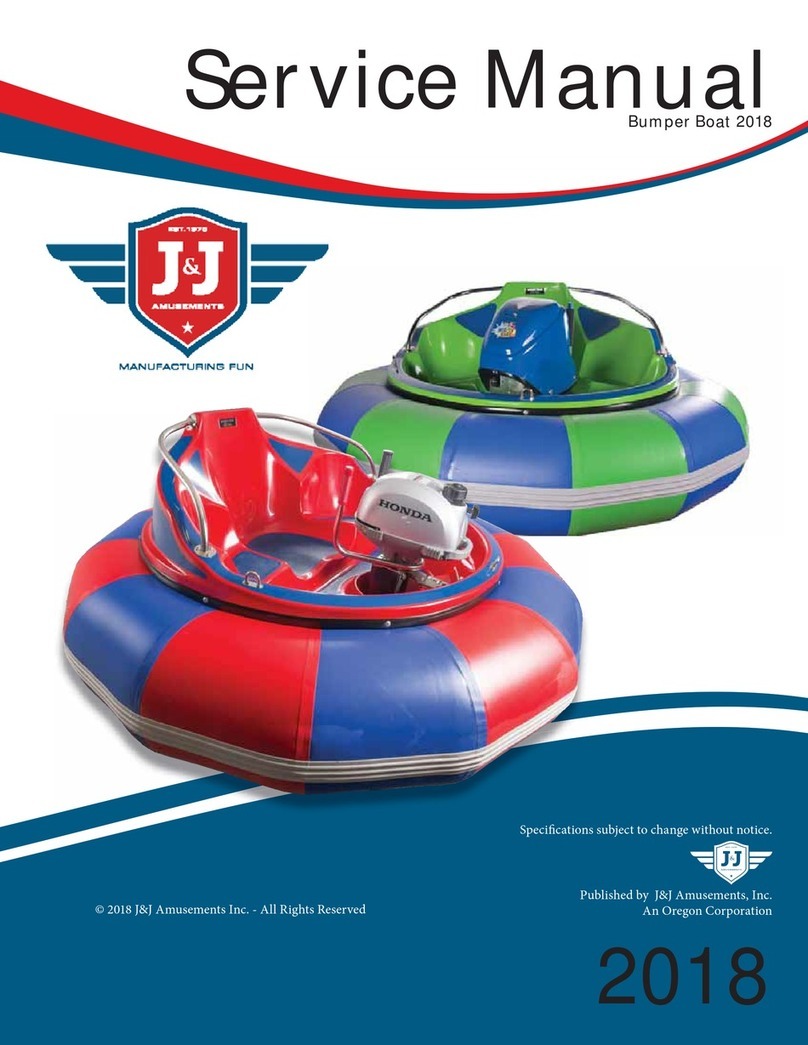
WARNING - Important Safety Notice
Proper service and repair procedures are vital to safe, reliable operation of J&J bumper boats, as well as to the personal
safety of those performing the repairs. This manual outlines procedures for servicing and repairing J&J bumper boats
using safe, effective methods. The procedures contain many NOTES, CAUTIONS and WARNINGS which should be
followed (along with standard safety procedures) to eliminate the possibility of personal injury or improper service,
which could damage the bumper boat or compromise its safety.
It is important to note that repair procedures, techniques, tools and parts for servicing J&J bumper boats, as well as the
skill and experience of the individual performing the work, vary widely. It is not possible to anticipate all conceivable
ways or conditions under which J&J bumper boats may be serviced, or to provide cautions to all possible hazards
that may result. Standard precautions should be used when handling toxic or flammable fluids, and safety goggles or
other protection should be used during cutting, grinding, chiseling, prying or any other process that can cause material
removal or projectiles. J&J recommends the use of safety goggles or approved glasses during all servicing of J&J bumper
boats.
All information contained in this manual is based on the latest product information available at the time of printing.
We reserve the right to make changes at any time without notice. All rights reserved. Except as expressly provided
herein, no part of the manual may be reproduced, copied, transmitted, disseminated, downloaded or stored in
any storage medium, for any purpose, without prior written consent of J&J Amusements, Inc. A Corporation of
Oregon. J&J Amusements, Inc. grants permission to download a single copy of this manual onto a hard drive or
other electronic storage medium to be viewed for personal use, provided that such electronic or printed copy of
this manual contains the complete text of this copyright notice. Any unauthorized commercial distribution of this
manual is strictly prohibited.
4897 Indian School Rd NE
Suite 150
Salem Oregon 97305-1126
www.jjamusements.com
Phone: 503-304-8899
Toll Free Phone: 800-854-3140
Fax: 503-304-1899
Toll Free Fax: 800-366-7505
JJ
&Amusements, Inc. Technical Contact Information
We value your feedback; technical comments
and suggestions are helpful to us. Please e-mail
From time to time, updates may be made
to this manual. For the latest updates,
please visit our technical website at
http://jjamusements.com/technical/index.htm.
As you read this manual, you will find information that is preceded by a NOTICE symbol. The purpose of this message is
to prevent damage to the bumper boat, other property, or the environment.
SAFETY MESSAGES
Your safety and the safety of others are very important. To help you make informed decisions, we have provided safety
messages and other information throughout this manual. Of course, it is not practical or possible to warn you about all the
hazards associated with servicing a bumper boat. You must use your own good judgement.
You will find important safety information in a variety of forms, including:
SAFETY MESSAGES - preceded by a safety alert symbol and one of four signal words:
DANGER, WARNING, CAUTION, or SAFETY ITEM.
These signal words mean:
‹ DANGER › You WILL be KILLED or SERIOUSLY INJURED if you do not follow the subsequent instructions.
‹ WARNING › You CAN be KILLED or SERIOUSLY INJURED if you do not follow the subsequent instructions.
‹ CAUTION › You WILL be INJURED if you do not follow the subsequent instructions.
‹ SAFETY ITEM › This safety device was installed at the factory and may be required by state, local, or ASTM standards.




























